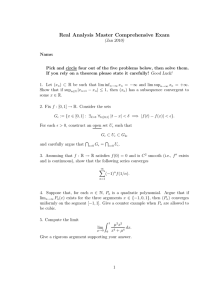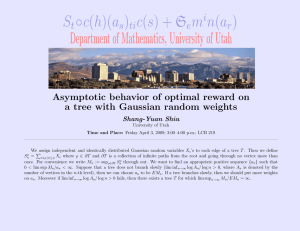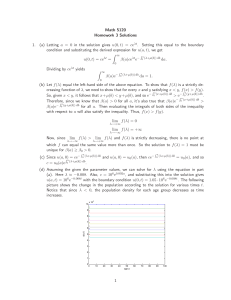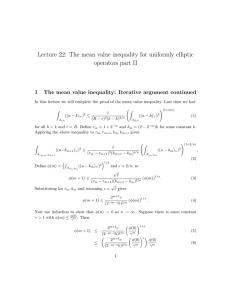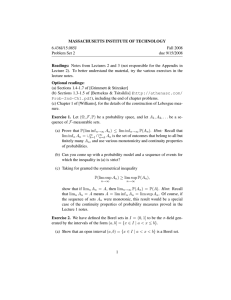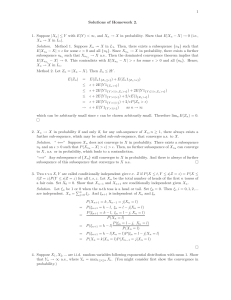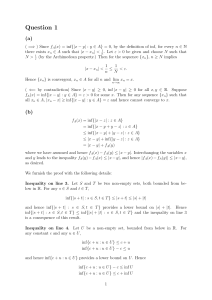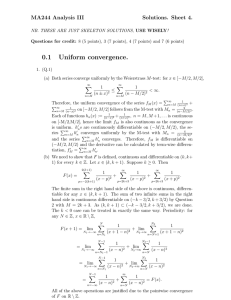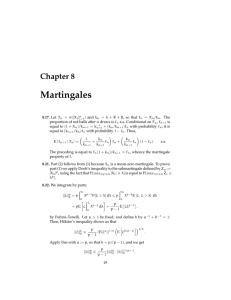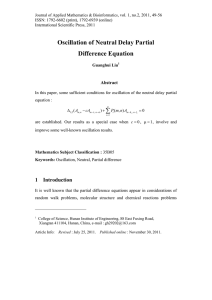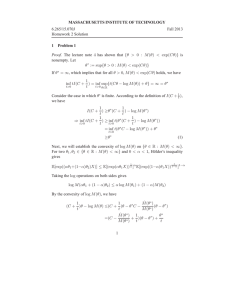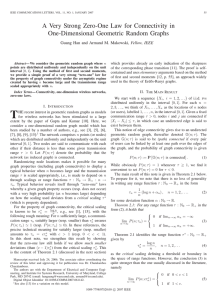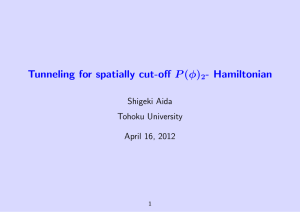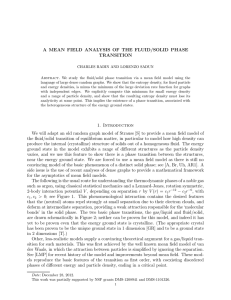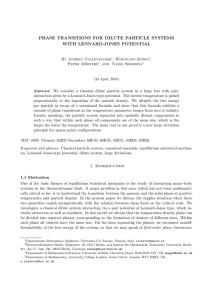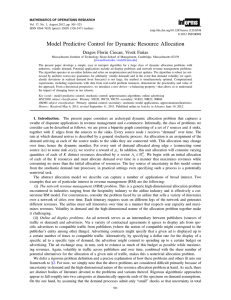Classical Probability Chapter 1
advertisement
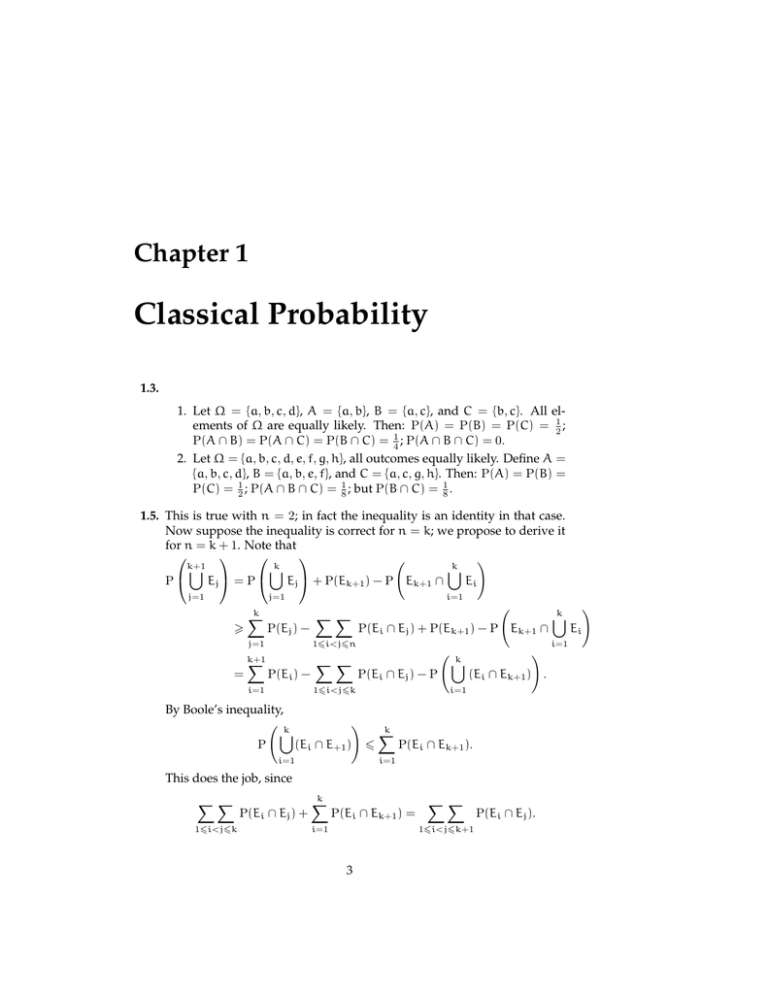
Chapter 1
Classical Probability
1.3.
1. Let Ω = {a, b, c, d}, A = {a, b}, B = {a, c}, and C = {b, c}. All elements of Ω are equally likely. Then: P(A) = P(B) = P(C) = 12 ;
P(A ∩ B) = P(A ∩ C) = P(B ∩ C) = 14 ; P(A ∩ B ∩ C) = 0.
2. Let Ω = {a, b, c, d, e, f, g, h}, all outcomes equally likely. Define A =
{a, b, c, d}, B = {a, b, e, f}, and C = {a, c, g, h}. Then: P(A) = P(B) =
P(C) = 12 ; P(A ∩ B ∩ C) = 18 ; but P(B ∩ C) = 18 .
1.5. This is true with n = 2; in fact the inequality is an identity in that case.
Now suppose the inequality is correct for n = k; we propose to derive it
for n = k + 1. Note that
�
�
k+1
k
k
�
�
�
P
Ej = P Ej + P(Ek+1 ) − P Ek+1 ∩
Ei
j=1
j=1
�
=
k
�
P(Ej ) −
i=1
��
j=1
1�i<j�n
k+1
�
��
P(Ei ) −
1�i<j�k
i=1
�
P(Ei ∩ Ej ) + P(Ek+1 ) − P Ek+1 ∩
P(Ei ∩ Ej ) − P
�
k
�
i=1
�
(Ei ∩ Ek+1 ) .
By Boole’s inequality,
� k
�
k
�
�
P
(Ei ∩ E+1 ) �
P(Ei ∩ Ek+1 ).
i=1
i=1
This does the job, since
��
1�i<j�k
P(Ei ∩ Ej ) +
k
�
i=1
P(Ei ∩ Ek+1 ) =
3
��
1�i<j�k+1
P(Ei ∩ Ej ).
k
�
i=1
Ei
�
4
CHAPTER 1. CLASSICAL PROBABILITY
1.15. Note that if r ∈ (0 , 1), then Zr is a complex-valued random variable.
Therefore, we have to be a little careful and write
Zr = Zr 1{Z>0} + (−1)r |Z|r 1{Z<0} .
Now,
�
r
�
E Z 1{Z>0} =
=
=
=
�∞
1
2
√
zr e−z /2 dz
2π 0
�∞
1
dw
√
(2w)r/2 e−w √
2π 0
2w
(r/2)−1 � ∞
2
√
w(r−1)/2 e−w dw
π
0
�
�
2(r−2)/2
r+1
√
Γ
.
2
π
(w := z2 /2)
Since Z and −Z have the same distribution, it follows that
�
�
�
�
�
� 2(r−2)/2
r+1
E |Z|r 1{Z<0} = E Zr 1{Z>0} = √
Γ
.
2
π
Therefore,
E(Zr ) =
2(r−2)/2
√
Γ
π
�
r+1
2
�
{1 + (−1)r } .
If r is a positive integer, then 1+(−1)r = 2 when r is even and 1+(−1)r =
0 when r is odd. Therefore, in that case, E(Zr ) = 0 when r is odd, and for
even values of r ,
�
�
2r/2
r+1
E(Zr ) = √ Γ
.
2
π
1.26. Let X = Unif(0 , T ); that is, for all t > 0,
�
1/t, if x ∈ (0 , t),
fX|T (x|t) =
0,
otherwise.
Therefore, the density function of (X , T ) is
�
e−t if 0 � x � t,
f(x , t) =
0
otherwise.
Hence, for all x � 0,
fX (x) =
�∞
x
Else, if x < 0 then fX (x) = 0.
e−t dt = e−x .
Chapter 2
Bernoulli Trials
2.2. Because ln(1 − ε) = −ε − 12 ε2 − 13 ε3 + · · · for all ε ∈ (0 , 1], it follows that
�
� �
�
1
1
1
1
j−
ln 1 −
= −1 −
−
··· .
2
j
12j2 12j3
Thus,
ln f(n) = 1 +
n �
�
j=2
�
� �
��
1
1
1+ j−
ln 1 −
� 1.
2
j
This gives the desired upper bound [limn→∞ f(n) � e]. Similarly, use
Taylor expansion with remainder to find that (j − 12 ) ln(1 − 1j ) � −1 −
�∞ −2
1
� 0. This yields the lower
(24j2 )−1 , so that ln f(n) � 1 − 24
j=2 j
bound [limn→∞ f(n) � 1].
2.10. Let σ := sup{x : p(x) > 0} and note that P{X � σ} = 1. It follows then
that E[Xn ] � σ for all n. Therefore, lim supn E[Xn ] � σ. It suffices to
prove that lim inf n E[Xn ] � σ.
First suppose σ < ∞. Choose and fix some ε ∈ (0, 1). By definition,
η := P{X � (1 − ε)σ} > 0. Therefore,
E[Xn ] � E [Xn ; X � (1 − ε)σ] � η(1 − ε)n σn .
This proves that lim inf n E[Xn ] � (1 − ε)σ. Let ε ↓ 0 to finish. Next
suppose σ = ∞. Then we can find x1 < x2 < . . . such that limk→∞ xk =
∞, and ηk := P{X � xk } > 0. Then,
E[Xn ] � E [Xn ; X � xk ] � ηk xn
k.
Therefore, lim inf n (E[Xn ])1/n � xk . Let k → ∞ to finish.
5
